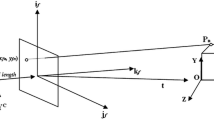Abstract
In this paper we describe an algorithm to recover the scene structure, the trajectories of the moving objects and the camera motion simultaneously given a monocular image sequence. The number of the moving objects is automatically detected without prior motion segmentation. Assuming that the objects are moving linearly with constant speeds, we propose a unified geometrical representation of the static scene and the moving objects. This representation enables the embedding of the motion constraints into the scene structure, which leads to a factorization-based algorithm. We also discuss solutions to the degenerate cases which can be automatically detected by the algorithm. Extension of the algorithm to weak perspective projections is presented as well. Experimental results on synthetic and real images show that the algorithm is reliable under noise.
Similar content being viewed by others
References
Avidan, S. and Shashua, A. 1999. Trajectory triangulation of lines: Reconstruction of a 3d pointmoving along a line from a monocular image sequence. In CVPR99.
Avidan, S. and Shashua, A. 2000. Trajectory triangulation: 3d reconstruction of moving points from a monocular image sequence. PAMI, 22(4):348–357.
Boult, T. and Brown, L.G. 1991. Factorization-based segmentation of motions. In Proceedings of the 1991 Visual Motion Workshop, pp. 179–186.
Bregler, C., Hertzmann, A., and Biermann, H. 2000. Recovering nonrigid 3d shape from image streams. In CVPR00, pp. II:690–696.
Christy, S. and Horaud, R. 1996. Euclidean reconstruction: From paraperspective to perspective. In ECCV96, pp. II:129–140.
Costeira, J.P. and Kanade, T. 1998.Amultibody factorization method for independently moving-objects. IJCV, 29(3):159–179.
Fischler, M.A. and Bolles, R.C. 1981. Random sample consensus: A paradigm for model fitting with applications to image analysis and automated cartography. CACM, 24(6):381–395.
Gear, C.W. 1998. Multibody grouping from motion images. IJCV, 29(2):133–150.
Han, M. and Kanade, T. 1998. Homography-based 3d scene analysis of video sequences. In DARPA98, pp. 154–160.
Han, M. and Kanade, T. 1999. The factorization method with linear motions.Technical Report CMU-RI-TR-99-23, Robotics Institute, Carnegie Mellon University.
Han, M. and Kanade, T. 2000. Reconstruction of a scene with multiple linearly moving objects. In CVPR00, pp. II:542–549.
Irani, M. 1999. Multi-frame optical flow estimation using subspace constraints. In ICCV99, pp. 626–633.
Irani, M., Anandan, P., and Cohen, M. 2002. Direct recovery of planar-parallax from multiple frames. PAMI, 24(11):1528–1534.
Irani, M., Anandan, P., and Weinshall, D. 1998. From reference frames to reference planes: Multi-view parallax geometry and applications. In ECCV98, pp. 829–845.
Irani, M., Rousso, B., and Peleg, S. 1992. Detecting and tracking multiple moving objects using temporal integration. In ECCV92, pp. 282–287.
Irani, M., Rousso, B., and Peleg, S. 1997. Recovery of ego-motion using region alignment. PAMI, 19(3):268–272.
Kumar, R., Anandan, P., and Hanna, K. 1994. Direct recovery of shape from multiple views:Aparallax based approach. In ICPR94, pp. 685–688.
Manning, R.A. and Dyer, C.R. 1999. Interpolating view and scene motion by dynamic view morphing. In CVPR99, pp. 388–394.
Poelman, C. and Kanade, T. 1997. A paraperspective factorization method for shape and motion recovery. PAMI, 19(3):206–218.
Sawhney, H., Guo, Y., Asmuth, J., and Kumar, R. 1999. Independent motion detection in 3d scenes. In ICCV99, pp. 612–619.
Shashua, A. and Wolf, L.B. 2000. Homography tensors: On algebraic entities that represent three views of static or moving planar points. In ECCV00.
Shashua, A., Avidan, S., and Werman, M. 1999. Trajectory triangulation over conic sections. In ICCV99, pp. 330–336.
Tomasi, C. and Kanade, T. 1992. Shape and motion from image streams under orthography: A factorization method. IJCV, 9(2):137–154.
Torr, P.H.S. and Murray, D.W. 1993. Outlier detection and motion segmentation. SPIE, 2059:432–443.
Wexler, Y. and Shashua, A. 2000. On the synthesis of dynamic scenes from reference views. In CVPR00, pp. II:576–581.
Wolf, L. and Shashua, A. 2001. On projection matrices p k–> p 2, k = 3,..., 6, and their applications in computer vision. In ICCV01, pp. I:412–419.
Zelnik-Manor, L. and Irani, M. 1999. Multi-view subspace constraints on homographies. In ICCV99, pp. 710–715.
Author information
Authors and Affiliations
Rights and permissions
About this article
Cite this article
Han, M., Kanade, T. Reconstruction of a Scene with Multiple Linearly Moving Objects. International Journal of Computer Vision 59, 285–300 (2004). https://doi.org/10.1023/B:VISI.0000025801.70038.c7
Issue Date:
DOI: https://doi.org/10.1023/B:VISI.0000025801.70038.c7




